air suspension Hyundai Equus 2010 Owner's Manual
[x] Cancel search | Manufacturer: HYUNDAI, Model Year: 2010, Model line: Equus, Model: Hyundai Equus 2010Pages: 374, PDF Size: 41.29 MB
Page 232 of 374
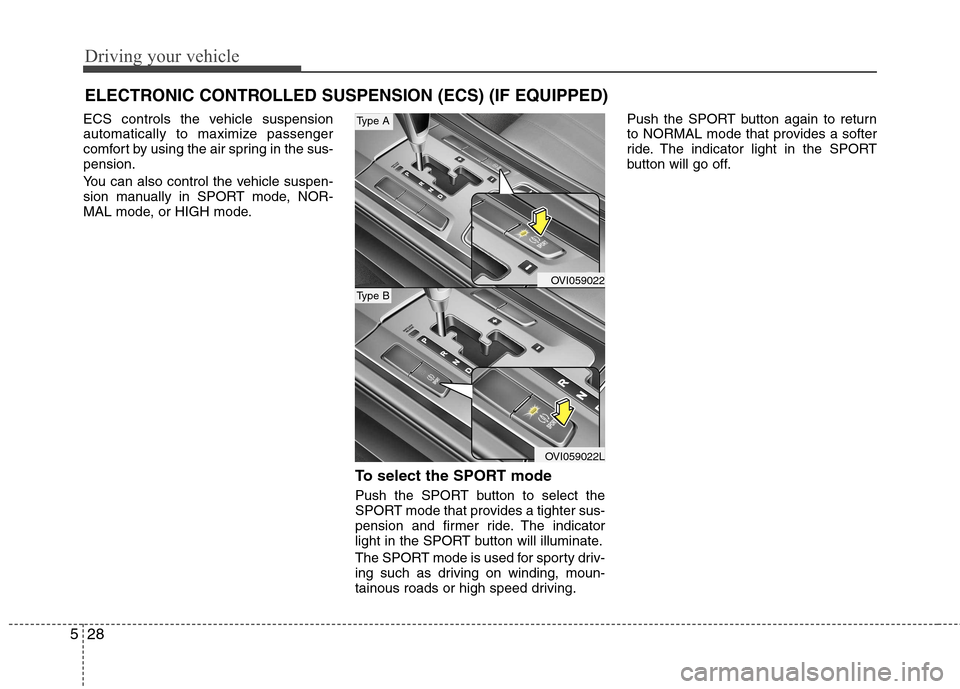
Driving your vehicle
28
5
ELECTRONIC CONTROLLED SUSPENSION (ECS) (IF EQUIPPED)
ECS controls the vehicle suspension
automatically to maximize passenger
comfort by using the air spring in the sus-pension.
You can also control the vehicle suspen-
sion manually in SPORT mode, NOR-
MAL mode, or HIGH mode.
To select the SPORT mode
Push the SPORT button to select the
SPORT mode that provides a tighter sus-
pension and firmer ride. The indicator
light in the SPORT button will illuminate.
The SPORT mode is used for sporty driv-
ing such as driving on winding, moun-
tainous roads or high speed driving.Push the SPORT button again to return
to NORMAL mode that provides a softer
ride. The indicator light in the SPORT
button will go off.
OVI059022
OVI059022L
Type B
Type A
Page 234 of 374
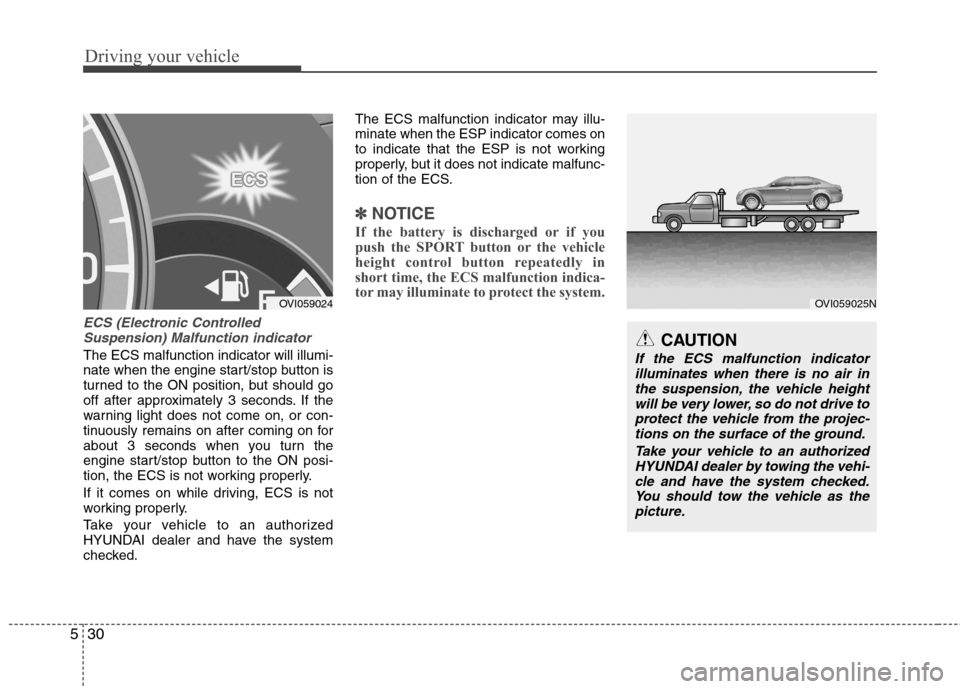
Driving your vehicle
30
5
ECS (Electronic Controlled
Suspension) Malfunction indicator
The ECS malfunction indicator will illumi-
nate when the engine start/stop button is
turned to the ON position, but should go
off after approximately 3 seconds. If the
warning light does not come on, or con-
tinuously remains on after coming on for
about 3 seconds when you turn the
engine start/stop button to the ON posi-
tion, the ECS is not working properly.
If it comes on while driving, ECS is not
working properly.
Take your vehicle to an authorized
HYUNDAI dealer and have the system
checked. The ECS malfunction indicator may illu-minate when the ESP indicator comes on
to indicate that the ESP is not working
properly, but it does not indicate malfunc-
tion of the ECS.
✽✽
NOTICE
If the battery is discharged or if you
push the SPORT button or the vehicle
height control button repeatedly in
short time, the ECS malfunction indica-
tor may illuminate to protect the system.
CAUTION
If the ECS malfunction indicator illuminates when there is no air inthe suspension, the vehicle height
will be very lower, so do not drive toprotect the vehicle from the projec-tions on the surface of the ground.
Take your vehicle to an authorizedHYUNDAI dealer by towing the vehi-
cle and have the system checked.You should tow the vehicle as the picture.
OVI059025NOVI059024
Page 286 of 374
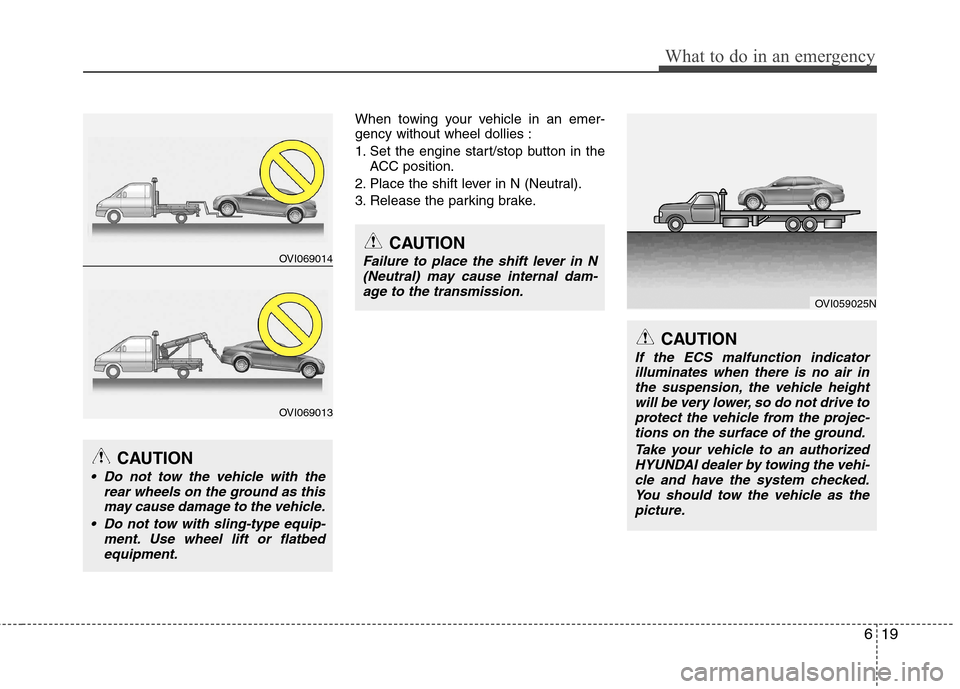
619
What to do in an emergency
When towing your vehicle in an emer- gency without wheel dollies :
1. Set the engine start/stop button in theACC position.
2. Place the shift lever in N (Neutral).
3. Release the parking brake.
OVI069014
OVI069013
CAUTION
Do not tow the vehicle with the rear wheels on the ground as thismay cause damage to the vehicle.
Do not tow with sling-type equip- ment. Use wheel lift or flatbedequipment.
CAUTION
Failure to place the shift lever in N
(Neutral) may cause internal dam-age to the transmission.
CAUTION
If the ECS malfunction indicator
illuminates when there is no air inthe suspension, the vehicle height will be very lower, so do not drive toprotect the vehicle from the projec-
tions on the surface of the ground.
Take your vehicle to an authorizedHYUNDAI dealer by towing the vehi-cle and have the system checked. You should tow the vehicle as the
picture.
OVI059025N
Page 302 of 374
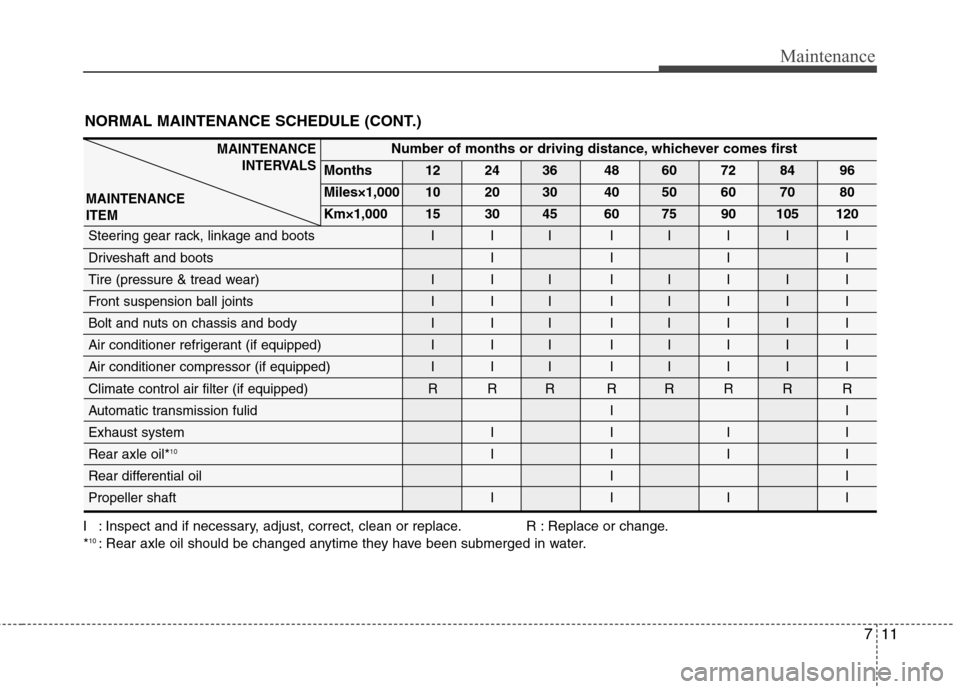
711
Maintenance
NORMAL MAINTENANCE SCHEDULE (CONT.)
I : Inspect and if necessary, adjust, correct, clean or replace. R : Replace or change. *10
: Rear axle oil should be changed anytime they have been submerged in water.
Number of months or driving distance, whichever comes first
Months 12 24 36 48 60 72 84 96
Miles×1,000 10 20 30 40 50 60 70 80
Km×1,000 15 30 45 60 75 90 105 120
Steering gear rack, linkage and boots I I I I I I I I
Driveshaft and boots I I I I
Tire (pressure & tread wear) I I I I I I I I
Front suspension ball joints I I I I I I I I
Bolt and nuts on chassis and body I I I I I I I I
Air conditioner refrigerant (if equipped) I I I I I I I I
Air conditioner compressor (if equipped) I I I I I I I I
Climate control air filter (if equipped) R R R R R R R R
Automatic transmission fulid II
Exhaust system I I I I
Rear axle oil* 10
IIII
Rear differential oil II
Propeller shaft
IIII
MAINTENANCE INTERVALS
MAINTENANCE ITEM
Page 303 of 374
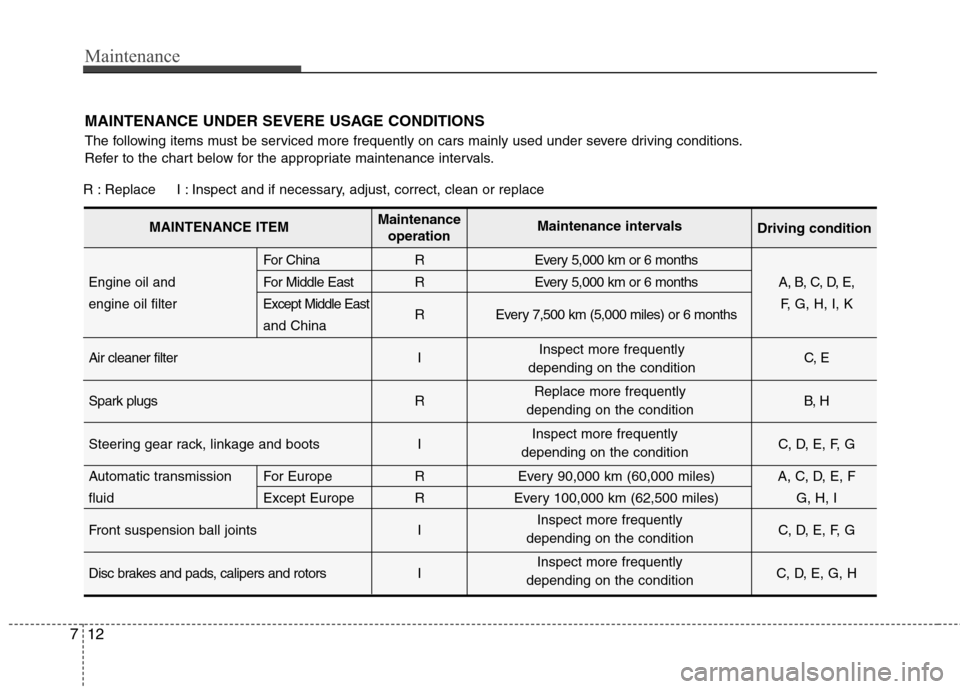
Maintenance
12
7
MAINTENANCE UNDER SEVERE USAGE CONDITIONS
The following items must be serviced more frequently on cars mainly used under severe driving conditions.
Refer to the chart below for the appropriate maintenance intervals.
R : Replace I : Inspect and if necessary, adjust, correct, clean or replace
For China R Every 5,000 km or 6 months
Engine oil andFor Middle East R Every 5,000 km or 6 months A, B, C, D, E,
engine oil filterExcept Middle EastR Every 7,500 km (5,000 miles) or 6 months F, G, H, I, K
and China
Air cleaner filter I C, E
Spark plugs R B, H
Steering gear rack, linkage and boots I C, D, E, F, G
Automatic transmission For Europe R Every 90,000 km (60,000 miles) A, C, D, E, F
fluid Except Europe R Every 100,000 km (62,500 miles) G, H, I
Front suspension ball joints I C, D, E, F, G
Disc brakes and pads, calipers and rotors I C, D, E, G, H
MAINTENANCE ITEMMaintenance
operation Maintenance intervals
Driving condition
Inspect more frequently
depending on the condition
Inspect more frequently
depending on the condition Replace more frequently
depending on the condition
Inspect more frequently
depending on the condition Inspect more frequently
depending on the condition
Page 307 of 374
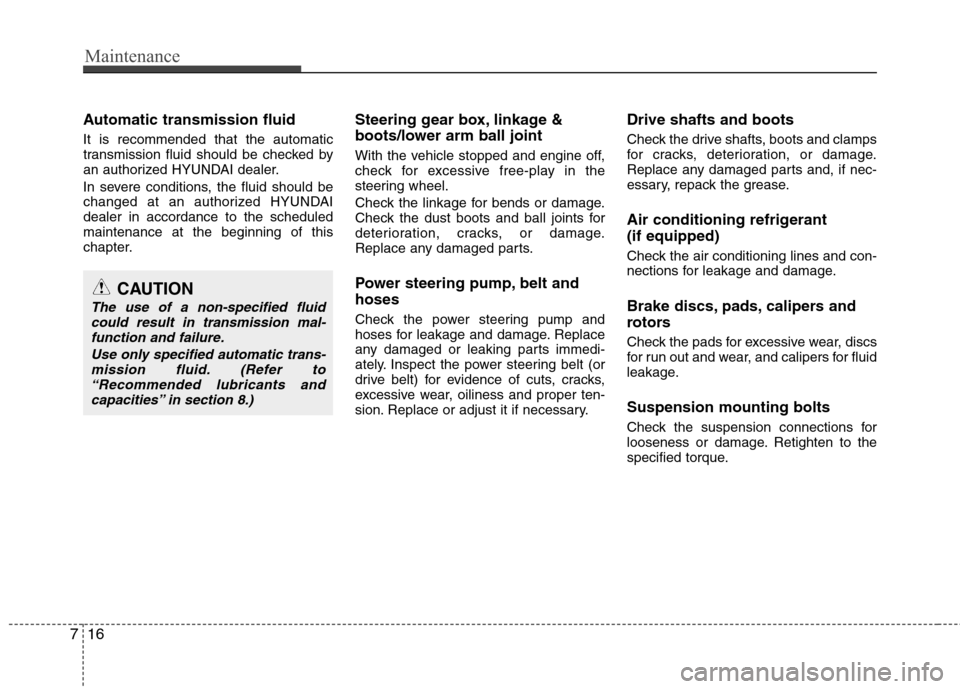
Maintenance
16
7
Automatic transmission fluid It is recommended that the automatic
transmission fluid should be checked by
an authorized HYUNDAI dealer.
In severe conditions, the fluid should be
changed at an authorized HYUNDAIdealer in accordance to the scheduledmaintenance at the beginning of this
chapter. Steering gear box, linkage &
boots/lower arm ball joint
With the vehicle stopped and engine off,
check for excessive free-play in the
steering wheel.
Check the linkage for bends or damage.
Check the dust boots and ball joints for
deterioration, cracks, or damage.
Replace any damaged parts.
Power steering pump, belt and hoses
Check the power steering pump and
hoses for leakage and damage. Replace
any damaged or leaking parts immedi-
ately. Inspect the power steering belt (or
drive belt) for evidence of cuts, cracks,
excessive wear, oiliness and proper ten-
sion. Replace or adjust it if necessary.Drive shafts and boots
Check the drive shafts, boots and clamps
for cracks, deterioration, or damage.
Replace any damaged parts and, if nec-
essary, repack the grease.
Air conditioning refrigerant (if equipped)
Check the air conditioning lines and con-
nections for leakage and damage.
Brake discs, pads, calipers and
rotors
Check the pads for excessive wear, discs
for run out and wear, and calipers for fluid
leakage. Suspension mounting bolts
Check the suspension connections for
looseness or damage. Retighten to the
specified torque.
CAUTION
The use of a non-specified fluid
could result in transmission mal-function and failure.
Use only specified automatic trans-mission fluid. (Refer to
“Recommended lubricants andcapacities” in section 8.)
Page 365 of 374

Specifications & Consumer information
2
8
Overall length 5,160 (203.1)
Overall width 1,890 (74.4)
Overall height 1,495 (58.8)
/ 1,490 (58.6)* 1
Wheelbase 3,045 (119.9)
Front tread 17" Tire 1,625 (64)
18" Tire 1,616 (63.6)
Rear tread 17" Tire 1,641 (64.6)
18" Tire 1,633 (64.29)
DIMENSIONS
Light Bulb Wattage
Headlights (Low) (HID) 35
Headlights (High) 55
Front turn signal lights 21 or LED*
Position lights LED
Side repeater lights* LED
Front fog lights* 35
Welcome light* LED
Rear fog light* LED
Stop and tail lights LED
Tail light* LED
Rear turn signal lights 21 or LED*
Back-up lights 16
High mounted stop light* LED
License plate lights LEDMap lamps LED
Room lamps LED
Luggage lamp* 5
Glove box lamp 5
Vanity mirror lamps* LED
Door courtesy lamps* 5
BULB WATTAGE
* : If equipped
*
1
: with air suspension mm (in)
Page 372 of 374
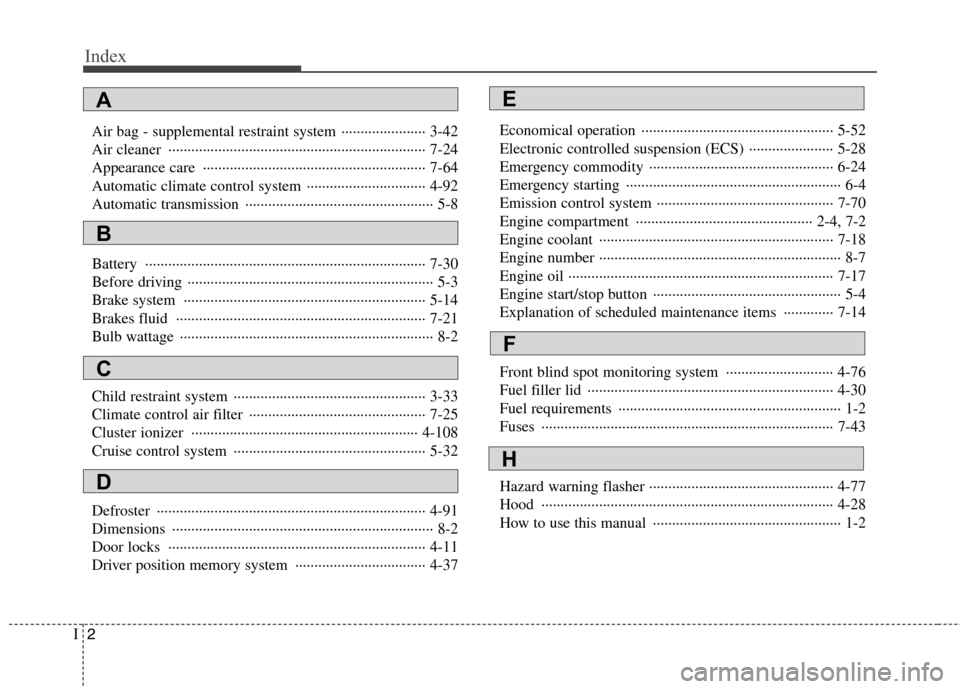
Index
2
I
Air bag - supplemental restraint system ······················ 3-42
Air cleaner ··································································· 7-24
Appearance care ·························································· 7-64
Automatic climate control system ······························· 4-92
Automatic transmission ················································· 5-8
Battery ········································································· 7-30
Before driving ································································ 5-3
Brake system ······························································· 5-14
Brakes fluid ································································· 7-21
Bulb wattage ·································································· 8-2
Child restraint system ·················································· 3-33
Climate control air filter ·············································· 7-25
Cluster ionizer ··························································· 4-108
Cruise control system ·················································· 5-32
Defroster ······································································ 4-91
Dimensions ···································································· 8-2
Door locks ··································································· 4-11
Driver position memory system ·································· 4-37 Economical operation ·················································· 5-52
Electronic controlled suspension (ECS) ······················ 5-28
Emergency commodity ················································ 6-24
Emergency starting ························································ 6-4
Emission control system ·············································· 7-70
Engine compartment ·············································· 2-4, 7-2
Engine coolant ····························································· 7-18
Engine number ······························································· 8-7
Engine oil ····································································· 7-17
Engine start/stop button ················································· 5-4
Explanation of scheduled maintenance items ············· 7-14
Front blind spot monitoring system ···························· 4-76
Fuel filler lid ································································ 4-30
Fuel requirements ·························································· 1-2
Fuses ············································································ 7-43
Hazard warning flasher ················································ 4-77
Hood ············································································ 4-28
How to use this manual ················································· 1-2
A
B
C
D
E
F
H